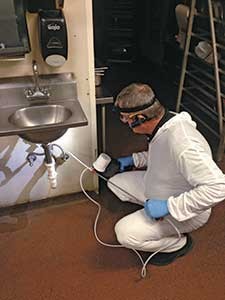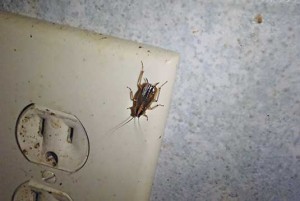
Washable and reusable coveralls keep insects and dirt off clothes, and are lighter than a polyester uniform. Photo: Jeff McGovern
In the mid-1970s, I was performing my first cockroach cleanouts of German cockroaches with the latest technology and best equipment of the day. We inspected the property and then proposed a full cockroach cleanout. It was the customer’s responsibility to completely prepare the property before we did any work. He was expected to remove all items from the cabinets in the kitchen and place them under a sheet on the table. This gave us complete access to the kitchen cabinets and countertops. I requested similar preparation of the bathrooms and bedrooms. Also, the customer was asked to leave the home before treatment began.
We carried a stainless-steel sprayer — loaded with an emulsifiable residual liquid mixed with a vapor action product — into the home. A hand duster filled with a blend of flushing material and residual was at the ready. In severe situations, I kept a fogger loaded with an appropriate pyrethrum material standing by.
I began application by spraying a residual layer of product. For cracks and crevices, the pinstream setting was used. Once that pass-through was complete, the dust was applied to force insects out through the residual materials. By this point, it was usually raining cockroaches. You could see and hear them falling all around you. For an even faster kill, we ran the fogger.
After using a broom and dustpan to clean up, we’d exit the property, leaving a trail of carcasses and death behind us for the customer to deal with.
Times have changed
Today, a site is accessed and evaluated first. In many commercial settings, a cockroach population mapping — the forced monitoring process — is done first to identify the distribution of the pest. This also can be done on residential jobs. It’s OK for the client to be on-site when the work begins, but usually it’s better if they’re not underfoot.
A vacuum cleaner is the first tool used — one with a high-efficiency particulate air (HEPA) cartridge to ensure all cockroaches and their associated filth is captured and contained. Zones are carefully opened and vacuumed, moving things around as little as possible so there’s minimal disturbance to the cockroach population. Otherwise, a technician risks spreading or flushing them into areas even more difficult to reach.
Next, a dry application tool places nonrepellent insecticide dust into cracks, crevices and voids. Again, it’s essential to kill in place without moving or spreading the population. Afterward, bait materials can be carefully placed to draw insects from deeper harborages. This also adds an additional killing component to the process.
Finally, a vacuum is used for cleanup so clients can return to peace of mind instead of massive death and destruction.
These two cleanouts occurred 40 years apart. In both cases, the customers were served with the best available technology of the day performed by dedicated, well-trained individuals. In the 1970s, they were exterminators becoming pest control operators (PCOs). Today, they’re PCOs who became pest management professionals (PMPs).
Click here to see a clean, but still common cockroach harborage technicians encounter.
You can reach Jeff McGovern at jeffreymcgovern@mindspring.com.

Leave A Comment